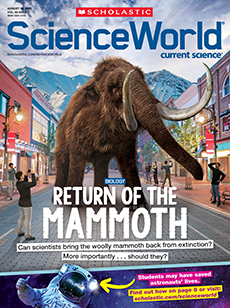JIM MCMAHON/MAPMAN ®
A few years ago, an American tourist peered out over a murky lake in Scotland and spotted something unusual in the water. He later described it as large, dark, and about the length of a school bus. But before he could snap a photo, the odd object disappeared beneath the surface.
The lake the man was visiting was Loch Ness, one of the largest in the United Kingdom. And he wasn’t the first person to spy something mysterious there. For centuries, people have reported seeing strange moving shapes in the lake’s cloudy waters. Many believe they’ve glimpsed an elusive creature known as the Loch Ness Monster, or Nessie for short.
There are plenty of theories about Nessie. Some people believe it’s a plesiosaur, an extinct prehistoric marine reptile that had a long neck. Others speculate that it’s an enormous fish. Or it could simply be a log. Although thousands of people have claimed to see Nessie, no one has been able to prove for certain that a large beast really lurks in the lake.
If there were any scientific evidence to support Nessie’s existence, Neil Gemmell thought he might know how to find it. Gemmell is a biologist at the University of Otago in New Zealand. In 2018, he rounded up an international team of scientists to travel to Scotland. “We set out to answer a simple question: What living things are in Loch Ness?” says Gemmell. “To answer the question, we planned to use a brand-new technology.”
A few years ago, an American visitor looked out over a murky lake in Scotland. He spotted something unusual in the water. Later, he said it was large, dark, and about the length of a school bus. But he didn’t have time to snap a photo. The odd object quickly disappeared beneath the surface.
The man was visiting Loch Ness. That’s one of the largest lakes in the United Kingdom. And he wasn’t the first person to see something unusual there. For centuries, people have claimed to see strange moving shapes in the lake’s cloudy waters. Many believe they’ve spotted a mysterious creature. It’s known as the Loch Ness Monster, or Nessie for short.
People have plenty of theories about Nessie. Some believe it’s a plesiosaur. This extinct prehistoric marine reptile had a long neck. Others think it’s a giant fish. Or it could just be a log. Thousands of people have claimed to have seen Nessie. But no one has been able to definitely prove that a large beast really lives in the lake.
Is there any scientific evidence that Nessie exists? If so, Neil Gemmell thought he might know how to find it. Gemmell is a biologist at the University of Otago in New Zealand. In 2018, he gathered an international team of scientists. They traveled to Scotland. “We set out to answer a simple question: What living things are in Loch Ness?” says Gemmell. “To answer the question, we planned to use a brand-new technology.”


 But he didn’t have time to snap a photo. The odd object quickly disappeared beneath the surface.
But he didn’t have time to snap a photo. The odd object quickly disappeared beneath the surface.